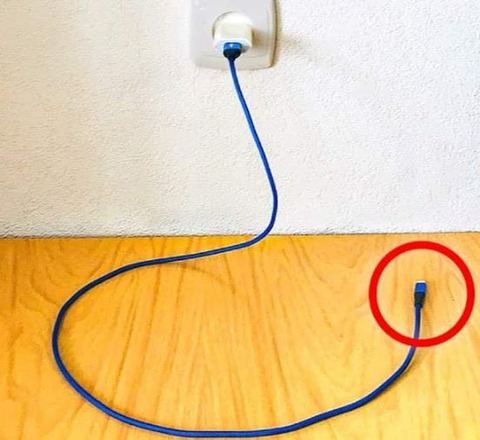In our tech-dependent world, leaving a phone charger plugged into an outlet without a phone attached has become an incredibly common habit. It’s a scene we see in almost every home, office, or even public space. Most people don’t think twice about it—after all, how much harm could such a small device cause when it’s not actively charging a phone? However, experts warn that this seemingly harmless practice has hidden consequences, including unnecessary energy consumption, increased electricity bills, potential fire hazards, and environmental implications. While it might seem like an insignificant detail in your daily routine, leaving your phone charger plugged in without your phone connected comes with risks worth understanding and addressing.

One of the most overlooked issues with leaving a phone charger plugged in is its continuous energy consumption. Even when it’s not charging a device, a phone charger still draws power from the outlet. Tests conducted on a standard Apple charger revealed that an idle charger can use approximately 130 watts of electricity per month, totaling about 1.5 kilowatt-hours of power annually. While this number seems small, the situation changes when you consider the number of chargers left plugged in across multiple households and workplaces. Larger chargers, like those used for tablets and laptops, consume even more energy, and non-branded or counterfeit chargers are often far less efficient, consuming up to 10 or 20 times more power when idle. The cumulative impact of millions of chargers continuously drawing power from outlets creates a significant strain on power grids and contributes to unnecessary carbon emissions. On an individual scale, the energy cost might seem minimal, but on a global scale, it represents a massive environmental burden.
Another critical concern is safety. While most branded phone chargers undergo rigorous testing and meet safety standards, they are not entirely risk-free. Over time, electrical components in chargers can degrade, increasing the chance of overheating, short circuits, or even fires. This risk becomes significantly higher when dealing with counterfeit or low-quality chargers, which are often poorly made and lack essential safety features. Chargers left plugged in and covered by flammable materials, such as clothing, bedding, or paper, are especially hazardous. Although experts like Glenn LaMay assure that certified phone chargers are designed to minimize fire risks, they also emphasize that poor-quality chargers are a different story entirely. Many reported house fires have been traced back to these substandard devices, which can overheat or malfunction even when idle.
From a financial perspective, leaving phone chargers plugged in also has an impact, albeit a subtle one. While a single charger left plugged in may only add a few cents to your annual electricity bill, the costs add up when multiple chargers across a home are constantly drawing power. Studies estimate that leaving five chargers plugged in year-round can cost approximately $0.37 annually. While this figure might seem insignificant, it represents money being wasted for no reason. Multiply that across millions of households, and the cost becomes far more substantial. With rising energy prices, every small saving counts, and eliminating phantom energy consumption from idle chargers is an easy and effective step toward lowering household energy bills.
Beyond the financial costs, the environmental implications of wasted electricity cannot be ignored. Every kilowatt-hour of energy consumed contributes to carbon emissions, particularly in regions where electricity is generated using fossil fuels. Idle chargers might not seem like significant energy hogs on their own, but their collective impact is staggering. Furthermore, older chargers, especially those used for power tools or outdated electronics, are notorious for their inefficiency and excessive energy consumption when left idle. These older models often lack modern energy-saving features, making them far worse culprits of phantom energy draw. Addressing this problem starts with simple awareness and action—unplugging chargers when not in use and replacing inefficient chargers with newer, energy-efficient alternatives.
Fortunately, reducing these risks doesn’t require expensive investments or major lifestyle changes. Start by making it a habit to unplug chargers when they’re not actively in use. If you find this inconvenient, consider using smart power strips or smart outlets. These devices allow you to cut power to multiple chargers with the flip of a switch or even control them remotely via smartphone apps. Smart outlets can also monitor energy consumption, giving you better insight into how much power your devices are using. Another important step is investing in high-quality, branded chargers. While they may cost more initially, they’re significantly safer, more energy-efficient, and less likely to overheat or malfunction compared to cheap, unbranded alternatives.
It’s also a good idea to take inventory of the chargers in your home, particularly older models used for laptops, power tools, or other electronics. These chargers are often less efficient and more prone to energy waste. Unplugging them when not in use or replacing them with modern, efficient alternatives can further reduce energy consumption and associated costs.
In a world where technology plays such a central role in our lives, it’s easy to overlook small habits like leaving a charger plugged in. But the reality is that these habits have real consequences—wasted energy, unnecessary costs, increased fire risks, and a larger carbon footprint. By adopting the simple habit of unplugging your phone charger when it’s not in use, you’re taking a small but meaningful step toward a safer, more sustainable, and cost-efficient future. It’s a minor adjustment in your daily routine, but one that delivers substantial benefits over time. In the end, a little effort goes a long way—both for your home and for the planet.